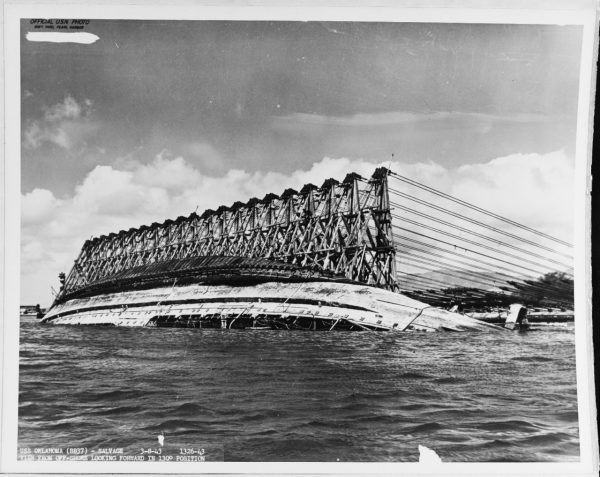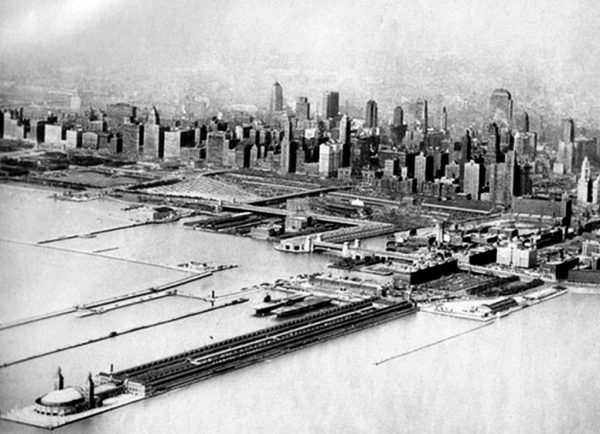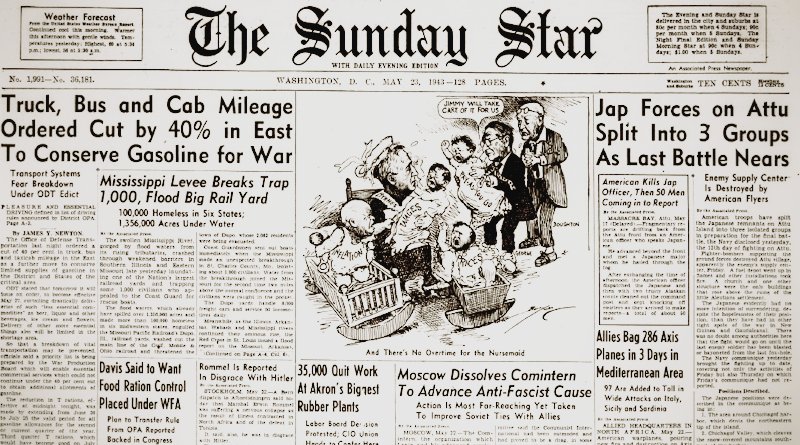World War II Chronicle: May 23, 1943
Click here for TODAY’S NEWSPAPER
Today’s headlines: Japs are being pounded on Attu, Allied aircraft are decimating the Luftwaffe in the Mediterranean, and crews have righted the battleship USS Oklahoma at Pearl Harbor…

The engineering required to right this ship is incredible. But the grunt work of going through the ship must have been something that very few people can relate to. 429 sailors and Marines perished aboard Oklahoma, and that was a year and a half ago. It would have been someone’s job to collect remains that have been decomposing all this time and to potentially identify them. If you’ve ever had the unpleasant experience of encountering a body several days after someone passed away, you have an idea how gruesome their job will be. Decades later, the Department of Defense had the unknown graves from USS Oklahoma disinterred so workers could identify the remains. 396 were identified and the rest were re-buried at the National Memorial Cemetery of the Pacific in Honolulu on Dec. 7, 2021…
Page four tells of even more destruction of Luftwaffe warplanes by the Soviets. If we can believe the numbers coming from Moscow, that brings the reported total of destroyed German aircraft over the past three days to 351. That is just what’s in two stories in today’s paper; surely more were destroyed in the European Theater. Many of the pilots shot down are killed or captured and will have to be replaced with new pilots. You can train replacements how to fly, but the combat experience that went down with these pilots can only be learned the hard way. The materials their planes were carrying, and now the amount of supplies that can’t be carried in the future is a devastating blow to the Wehrmacht. Combat troops need food, fuel, ammunition, clothing, replacement parts, and they need it now. It doesn’t matter if Germany has the world’s best fighting men — they can’t whip anyone if they aren’t adequately supplied. And their pipeline just got a lot smaller. Factories that would have devoted their limited time and resources to fighters and bombers, but instead of turning out a weapon to use against the Allies, they will have to rebuild their air transport capacity…
George Fielding Eliot column on page seven… A new 240-mm. M1 howitzer is pictured on page15. The “Black Dragon” takes about two hours to set up and requires separate vehicles to carry its barrel and carriage, plus a crane for assembly (story on page 20)… This week in the war is summarized on page 29… Sports section begins on page 35… Way back on page 98 is a picture of USS Sable, a former sidewheel steamer converted into a carrier qualification training unit — an aircraft carrier for future Naval aviators to practice takeoffs and landings. Future president George H.W. Bush will train on this ship. In fact, the 18-year-old Bush will be commissioned an ensign in the Naval Reserve in just a few days, becoming the youngest pilot in the Navy.

Roving Reporter by Ernie Pyle
IN TUNISIA — (by wireless) — Most of the German prisoners have been worked out of the forward Tunisian area by now. Where they went we don’t know. They’ve just left for the west.
Handling them and feeding them must be a tremendous job. It takes a lot of transportation to move those thousands of men back across Africa, and if we kept them in Africa we would have to use valuable shipping space bringing them food.
This colossal batch of humans is, indeed, a white elephant on our hands. And yet, as somebody says, what we want is about 50 more white elephants just like this one.
Although they are usually friendly and pleasant, you seldom find a prisoner who has any doubt that Germany will win the war. They say they lost here because we finally got more stuff into Tunisia than they had. But they laugh at the idea of our invading the continent. On the whole they can’t understand why America is in the war at all, figuring it is not our business.
Whether from deliberate Nazi propaganda or mere natural rumor I don’t know, but the prisoners have a lot of false news in their heads. For instance, some of them had heard that Japan had been at war with Russia for six months and had practically cleaned the Russians out of Siberia. One of them heard that the Luftwaffe had bombed New York. When told that this was ridiculous, he said he didn’t see himself how it could be possible.
Pvt. Bill Connell of Brooklyn had a funny experience. He was talking with an English-speaking prisoner, and the conversation finally unearthed the information that, as Private Connell says, “We know different people together” — meaning I’m sure that they had once actually lived in adjoining houses in Brooklyn — Connell at 251 Grove Street, and the German at 253 Grove. But that coincidence didn’t cause any old-palship to spring up between them, for the prisoner was one of those bull-headed Nazis and Connell got so disgusted that he didn’t even ask his name.
The prisoner was very sarcastic, and said to Connell:
“You Americans are saps. You’re still in the war, and I’m out of it.”
I thought Connell’s answer was pretty good. He replied:
“You’re such a hot Nazi, but it’s lots of good you’re going to do your country from now on.”
The first contacts of our troops with prisoners were extremely pleasant. So pleasant in fact that American officers got to worrying because the men found the Germans so likeable. But if you talk to them long enough you find in them the very thing we are fighting this war about — their superior-race complex, their smug belief in the divine right to run this part of the world. A little association with a German prisoner, like a little knowledge, is a bad thing, but if our troops could just have an opportunity to talk at length with the Germans I think they would come out of it madder than ever before at their enemy.
Captured supplies show that the Germans use excellent materials in all their stuff. However, it seems to us that there is some room for improvement in their vaunted efficiency. They have more of a hodge-podge and more overlapping designs than we do. They have big 10-wheeler troop carriers with seats running crosswise, but it is far too much vehicle for the service it performs. It can’t possibly be used for any other work than troop-carrying, and even for that it is an easy target, with men sitting up there in the open. And it is slow.
They also have a gadget that resembles a motorcycle except that the back end runs on two small caterpillar tracks instead of wheels. It’s a novel idea, but as somebody says it can carry only three men and there’s enough material wasted to make a young tank.
In rummaging around one supply dump I came upon a stack of copies of a new booklet entitled “Tausend Worte Italienisch.” I picked up a handful, thinking to glean a little backyard Italian. It didn’t occur to me at the time that the booklets obviously would be translating Italian into German.
The Germans do things thoroughly; we have to admit. My handful of booklets turned out not to be several copies of the same thing but a whole series of different booklets comprising a set of lessons for troops complete enough to give you a college course in Italian.
It seems a prodigal way to use money, yet I suppose it does make things better if the Germans are able to insult their allies in their own language.
Evening star. (Washington, D.C.), 23 May 1943. Chronicling America: Historic American Newspapers. Lib. of Congress.
https://chroniclingamerica.loc.gov/lccn/sn83045462/1943-05-23/ed-1/
